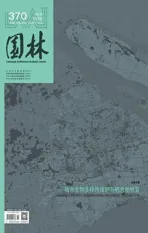谈提升城市生物多样性水平的策略与途径
2023-02-22张浪
联合国《生物多样性公约》第15次缔约国会议(COP15)于2021年10月、2022年12月,分别在中国昆明、加拿大蒙特利尔召开了两个阶段的会议。前者开启了全球生物多样性治理的新纪元,提出在2050年全面实现“人与自然和谐共生”的愿景;后者通过“昆明—蒙特利尔全球生物多样性框架”后,各国就调动资金、技术和能力支持,建立执行机制和国家行动计划,推进“框架”得以达成并实施,迅速扭转全球生物多样性丧失的趋势等目标达成一致。联合国人居署在最新发布的《2022世界城市状况报告》中指出,全球城镇人口的占比将从2021年的56%上升至68%,未来还将有更多的人口陆续进入城市。中国是世界上生物多样性最丰富的国家之一,也是生物多样性受威胁程度最严重的国家之一。城市生物多样性不仅对提高城市居民的环境保护意识有着重要的社会价值,也对城市环境的改善和城市的可持续发展具有重要的作用和意义。但是,城市生物多样性正面临着众多威胁,如城市建设导致生境破碎化、气候和局地环境变化、外来物种入侵等,造成城市生态系统服务功能降低。
生物多样性是生态学的重要表征与核心目标。在具有相当面积和人口聚集,经济活动和经济市场交织的城市区域内,城市生物多样性是城市生态环境与人类之间、生物与生境之间、生物之间复杂关系的体现。城市生物多样性的属性决定其不仅依赖自然演替形成的生态系统,更依赖人工建成的生态系统;不仅包括本土生长和繁殖的物种,也包括从其他地区传播或迁徙而来的物种。相对自然和乡村,城市生物物种的组成有其特殊性,如罕见体型较大的动物;植物群落以人工营造为主;物种生境更易受到建筑、道路以及人为侵扰等影响而呈现破碎化,甚至退化、丧失等现象。近年来,与城市生物多样性密切相关的全球气候变化、城市微气候、生态系统服务、基于自然的解决方案、生态保护红线等议题成为风景园林学科的重要关注内容。通过加强绿色基础设施建设,构建良好的生态网络和生物生境,提高生态系统的连通性,助力城市生物多样性保护。
本期专题“城市生物多样性保护与栖息地修复”,归纳城市湿地公园中两栖类动物栖息地特征,提出基于两栖类动物栖息地营建的湖泊型湿地公园景观格局、水系、植被、道路和桥涵等方面的设计方法与营建措施;归纳鱼类栖息地生境质量受水质(水温、溶解氧、pH值、含沙量)、水力学(水深、流速)、水文(流量)、地形、岸际条件、底质、河道内覆盖以及人类活动等因子的影响显著,探讨从水域设计(水深、底质、岸线、生态驳岸、生态岛、断面设计、微生境)、植物设计、水质管养等方面的栖息地构建策略;剖析日本的城市生物多样性治理措施,提出从加强法律体系建设、理顺管理体制机制、形成考核比较机制、完善规划传导机制、建设公众参与机制等方面对中国城市生物多样性治理的5点启示与建议;分析城市校园环境中的鸟类生境,总结鸟类多样性受植被丰富度、植被垂直结构、空间形态及空间层次复杂程度、人为干扰等多种因素的复合影响。
城市生物多样性保护的复杂程度远超于自然地的生物多样性保护,因此,城市生物多样性的研究不应拘泥于传统的生态学理论。在《生物多样性公约》框架下,结合多空间尺度、多水平开展相关研究工作,结合交叉学科共同探讨完整的方法体系,尤其是搭建风景园林学与生态学之间的桥梁,才能更好地实现提升城市生物多样性保护水平的目标,推进城市人与自然的协调发展。
主编
2023年1月11日
Strategies and Ways to Improve Urban Biodiversity
The 15th Conference of Parties to the United Nations Convention on Biological Diversity was held in Kunming, China in October 2021 and Montreal, Canada in December 2022. The former ushered in a new era of global biodiversity governance,and proposed the vision of “harmonious coexistence between man and nature” in 2050; the latter adopted the “Kunming-Montreal Global Biodiversity Framework”, in which countries agreed on the goals of mobilizing financial, technical and capacity support, establishing implementation mechanisms and national action plans, promoting the achievement and implementation of the “Framework”, and rapidly reversing the trend of global biodiversity loss. UN Habitat pointed out in the latest Report on the State of World Cities in 2022 that the proportion of global urban population will rise from 56% in 2021 to 68%, and more people will enter cities in the future. China is one of the countries with the richest biodiversity in the world, and also one of the countries with the most serious threat to biodiversity. Urban biodiversity not only has an important social value for improving the environmental protection awareness of urban residents, but also plays an important role in the improvement of urban environment and the sustainable development of cities. However, urban biodiversity is facing many threats, such as habitat fragmentation caused by urban construction, climate and local environmental changes, alien species invasion, etc., resulting in the decline of urban ecosystem services.
Biodiversity is an important characterization and core goal of ecology. Urban biodiversity reflects the complex relationship between urban ecological environment and human beings, between organisms and habitats, and between organisms. The attribute of urban biodiversity determines that it depends not only on the ecosystem formed by natural succession, but also on the artificial ecosystem; it includes not only species that grow and reproduce locally, but also species that spread or migrate from other regions. Compared with nature and countryside, the composition of urban biological species has its particularity, such as rare large animals; the plant community is mainly artificially constructed; the habitat of species is more vulnerable to the impact of buildings, roads and human intrusion, which leads to fragmentation, even degradation and loss. In recent years, topics closely related to urban biodiversity, such as global climate change, urban microclimate, ecosystem services, nature-based solutions, and ecological protection red lines, have become important subjects of landscape architecture. By strengthening the construction of green infrastructure, we will build a good ecological network and biological habitat, improve the connectivity of the ecosystem, and help protect urban biodiversity.
In this issue, the topic “Urban Biodiversity Conservation and Habitat Restoration”summarized the characteristics of amphibian habitats in urban wetland parks, and proposed design methods and construction measures for landscape pattern, water system, vegetation, roads, bridges and culverts of lake wetland parks based on amphibian habitats; it was concluded that the habitat quality offish habitat is significantly affected by water quality, hydraulics, hydrology, topography, coastal conditions, sediment,river channel coverage and human activities, and the habitat construction strategies from water design, plant design, water quality management and other aspects were discussed; the urban biodiversity governance measures in Japan were analyzed and five inspirations and suggestions for urban biodiversity governance in China from the aspects of strengthening the construction of legal system, streamlining the management system and mechanism, forming the assessment and comparison mechanism,improving the planning transmission mechanism, and building the public participation mechanism were put forward; besides, the opinion was summarized that the bird diversity is affected by multiple factors, such as vegetation abundance, vertical structure of vegetation, spatial form and complexity of spatial hierarchy, and human interference.
The complexity of urban biodiversity conservation is much higher than that of natural biodiversity conservation, so the study of urban biodiversity should not be confined to the traditional ecological theory. Under the framework of Convention on Biological Diversity, relevant research should be carried out at multiple spatial scales and at multiple levels, and a complete methodological system should be discussed together with cross-disciplines, especially to build a bridge between landscape architecture and ecology. Only in this way can we better achieve the goal of improving the level of urban biodiversity conservation and promote the coordinated development of urban man and nature.
Editor-in-Chief
January 11th, 2023
